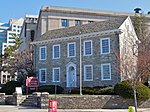Trenton War Memorial

Trenton and Mercer County War Memorial-Soldiers' and Sailors' Memorial Building, known as the Trenton War Memorial, is located in Trenton, Mercer County, New Jersey, United States. The building was built in 1930 and was added to the National Register of Historic Places on December 11, 1986. It was designed by Louis S. Kaplan (1896-1964), who as a young architect won a competition to design Trenton's memorial to its Dead from World War One. Kaplan then supervised the building of the War Memorial, and after its dedication became the leading architect in Trenton until the early 1960s. Built as a concert hall, it fell into disrepair before being restored by the State of New Jersey in the 1990s. It was rededicated in 1999. The 1,807-seat theater at the War Memorial was renamed the Patriots Theater in 2001.
Excerpt from the Wikipedia article Trenton War Memorial (License: CC BY-SA 3.0, Authors, Images).Trenton War Memorial
Memorial Drive, Trenton
Geographical coordinates (GPS) Address External links Nearby Places Show on map
Geographical coordinates (GPS)
| Latitude | Longitude |
|---|---|
| N 40.218333333333 ° | E -74.768333333333 ° |
Address
Patriots Theater at the War Memorial
Memorial Drive
08608 Trenton
New Jersey, United States
Open on Google Maps









